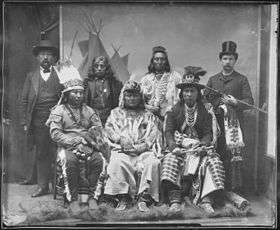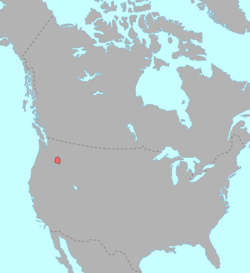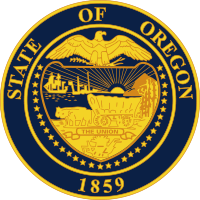Cayuse people
|
The Cayuse Tribe land area | |
| Total population | |
|---|---|
| (2010: 304 alone and in combination[1]) | |
| Regions with significant populations | |
| Washington, Oregon | |
| Languages | |
| English, Cayuse (extinct) | |
| Religion | |
| Animism, Christianity | |
| Related ethnic groups | |
| Umatilla, Walla Walla, Nez Perce |

%2C_a_Cayuse_chief%2C_full-length%2C_standing%2C_wearing_a_feathered_head-dress%2C_09-1909_-_NARA_-_531112.tif.jpg)
The Cayuse are a Native American tribe in the state of Oregon in the United States. The Cayuse tribe shares a reservation and government in northeastern Oregon with the Umatilla and the Walla Walla tribes as part of the Confederated Tribes of the Umatilla Indian Reservation. The reservation is located near Pendleton, Oregon at the base of the Blue Mountains.
The Cayuse called themselves the Liksiyu in the Cayuse language.[2] Originally located in present-day northeastern Oregon and southeastern Washington, they lived adjacent to territory occupied by the Nez Perce and had close associations with them. Like the Plains tribes, the Cayuse placed a high premium on warfare and were skilled horsemen. They developed the Cayuse pony. The Cayuse ceded most of their traditional territory to the United States in 1855 by treaty and moved to the Umatilla Reservation, where they have formed a confederated tribe.
History
According to Haruo Aoki (1998), the Cayuse called themselves Liksiyu in their language.[2] Their name Cayuse was derived from a French word for them, adopted by early Canadian trappers of the area. The tribe has been closely associated with the neighboring Nez Percé and Walla Walla. The Cayuse language is an isolate, independent of the neighboring Sahaptin-speaking peoples.
The Cayuse Indians were a nomadic tribe that occupied territories at the heads of the Walla Walla, Umatilla, and Grande Ronde Rivers, and from the Blue Mountains to the Deschutes River in Washington and Oregon.
The Cayuse were known for their bravery and as horsemen. They bred their ponies for speed and endurance, developing what is now called the Cayuse horse. They frequently were in conflict with the Snake people and other smaller tribes.
As white settlers moved into their territory in large numbers following the opening of the Oregon Trail in 1842, the Cayuse suffered. Even settlers passing through competed with them for game and water. Crowds of whites invaded the region during the California Gold Rush beginning in 1848 and when gold was discovered in Eastern Oregon in 1862.
The tribe gained wide notoriety in the early days of the white settlement of the territory. In 1838, Marcus Whitman and his wife Narcissa established a mission among the Cayuse at a site about seven miles from the present-day city of Walla Walla. In 1847, a measles epidemic, contracted from white settlers, resulted in high fatalities among the tribe. A small group of Cayuse, believed the missionaries were deliberately poisoning their native people, since a much higher percentage of the natives were dying from the measles than were the whites. (Native Americans had no immunity to the endemic Eurasian diseases carried by European Americans.) In addition, cultural differences and settler encroachment had caused growing tensions.
The Cayuse attacked the missionaries, killing Whitman and his wife Narcissa, and eleven others. They captured 54 European-American women and children and held them for ransom. They destroyed the mission buildings. This attack prompted an armed response by the United States and the Cayuse War ensued.
The Cayuse put the captives to work together with their members; the adults made clothing for the tribe. They released the hostages after the Hudson's Bay Company brokered an exchange of 62 blankets, 63 cotton shirts, 12 Hudson Bay rifles, 600 loads of ammunition, 7 pounds of tobacco and 12 flints for the return of the now 49 surviving prisoners. The Cayuse eventually lost the war. They were forced to cede their land to the US and shared a reservation with the Umatilla and Walla Walla.
By 1851, the Cayuse had long intermarried with the neighboring Nez Percé, with whom they had sheltered; many learned their language.
In 1855, the Cayuse joined the treaty with the Umatilla and Walla Walla by which the Umatilla Indian Reservation was formed. Since that time, they have officially resided within the reservation's limits. During the mid-twentieth century, some members moved to cities under the Indian Relocation Act of 1956, an effort to give better access for contemporary jobs.
Their number was officially reported as 404 in 1904; this number may be misleading. A count in 1902 found one pure-blooded Cayuse on the reservation. Descendants with ancestry partially of the other tribes may still have identified as Cayuse. The Cayuse language is believed to have become extinct by then. As the members of the three tribes have intermarried, they no longer keep separate population numbers.
Lifestyle
The Cayuse Indians were located in the Columbia Basin and were nomadic, sometimes moving on a daily basis. They lived in teepees, which many nomadic tribes used for portability. The Cayuse were skilled horsemen, and used horses in hunting. They also used them for their trip over the Rocky Mountains each year to hunt a supply of buffalo to bring back for their families. The men hunted game and fished salmon. The women gathered and picked berries and dug and processed roots. The women also processed the animal skins to make materials for shelter and clothing. The men considered bravery to be an important quality, with brave warriors being held in high esteem. The strongest would be made chief.
Language
The Cayuse language is a language isolate. Scholars have proposed that it may be related to Molala, making up a Waiilaptuan family ultimately related to the Penutian stock. This proposal is unproven. The language has been extinct since the 19th century.
Weyíiletpuu is a dialect of the Nez Perce language as used by the Cayuse people of the Confederated Tribes of the Umatilla Indian Reservation. A distinctive dialect of the Cayuse people has not been used since the 1940s and is designated as extinct.[3]
Cuisine
The Cayuse's main food source was salmon from the Columbia River. They also hunted deer, as well as small game such as rabbits and fowl. Additionally, the women gathered roots and berries, processing them for cooked and dried foods for their journeys.
Notable Cayuse
- Tawatoy (known as Young Chief), Head Chief, uncle and predecessor of the next Young Chief (Weatenatemany), was a well-known leader and warrior[4]
- Weatenatemany (also known as Young Chief, c.18??–1859), Head Chief, nephew of Tawatoy, became the new Young Chief in October 1853, leader of the more conciliatory faction of the Cayuse, killed in a skirmish with the Snake during the summer of 1859.[4]
- Five Crows (also known as Achekaia or Hezekiah), brother and first successor of Tauitau, and leader of the hostile Cayuse, principal rival to Tauitau's son Young Chief (Weatenatemany) for the role of Head Chief, [4]
Footnotes
- ↑ "2010 Census CPH-T-6. American Indian and Alaska Native Tribes in the United States and Puerto Rico: 2010" (PDF). www.census.gov. Retrieved 2015. Check date values in:
|access-date=(help) - 1 2 Haruo Aoki (1998), A Cayuse Dictionary based on the 1829 records of Samuel Black, the 1888 records of Henry W. Henshaw and others, Manuscript. The Confederated Tribes of the Umatilla Indian Reservation.
- ↑ "The Language of Nixyáawii". Confederated Tribes of the Umatilla Indian Reservation. Retrieved 2014-12-29.
- 1 2 3 Young Chief (Weatenatemany), Washington History
Further reading
- Robert H. Ruby and John A. Brown, The Cayuse Indians: Imperial Tribesmen Of Old Oregon. Norman, OK: University of Oklahoma Press, 1972.
- Clifford E. Trafzer, Yakima, Palouse, Cayuse, Umatilla, Walla Walla, and Wanapum Indians, Scarecrow Press, 1992
External links
- Confederated Tribes of the Umatilla Indian Reservation, official website

